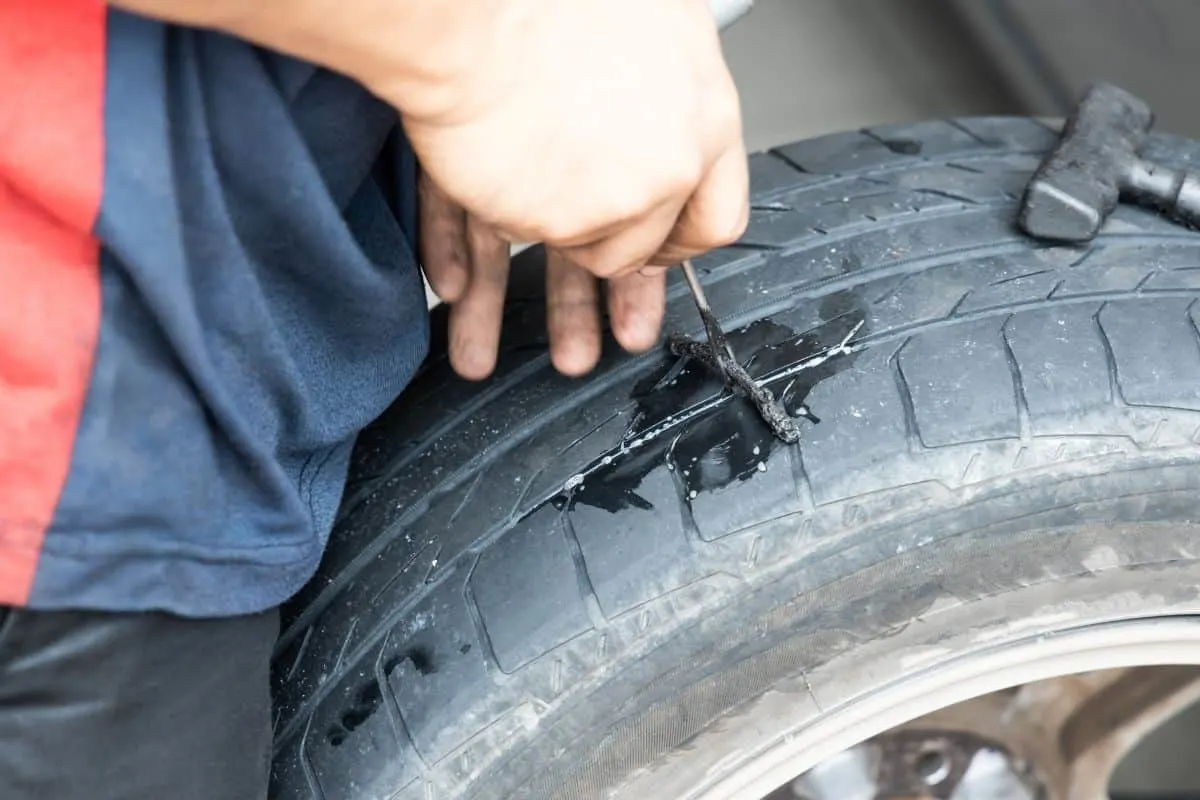Roads of varied terrain are always fun, but a flat tire comes with frowns flatter than the tire! Nobody wants to change off a tire that still has a healthy thread on it, so you may find yourself wondering if you can plug a tire or if doing so will ruin it.
A tire plug will not ruin a tire, however, a standalone tire plug is not meant to be used as a permanent fix. They should only be used temporarily to allow for enough time to perform a proper repair.
Interested in learning more about when and how to best use a tire plug? Then make sure to read on!
Plugging Tires: Know your circumstances.
The immediate and fast solution to a punctured tire is plugging it. As soon as the tire is punctured, the air leaks out gradually, leading to a flat.
However, it’s vital to inspect the nature of the tire and the damage before opting in for any repairs.
Depending on the severity of the damage and the puncture location, the tire can be either plugged, sealed, or opted for replacement. In such a situation, you need assistance from a specialist.
Plugging is the process of repairing a punctured tire by sealing the point of a leak with a tire plug. It is a sticky expandable object that is pushed into the hole in the tire with the help of a vulcanizing fluid.
Though it is a quick fix and cheap fix, there are situations where you can and cannot plug your tires!
Are you using a tubeless or an RFT?
Unlike tubeless tires, a run-flat tire is not advisable to be plugged when it goes flat. Instead, sealing the inner walls with a silicon sealant can be a viable option.
The process is comparatively more expensive than plugging, but it may be the only option available apart from changing to a new tire.
For a punctured RFT, you can apply 8-10mm of silicone sealant to the inner layer of the tire or from above. However, the tire is to be replaced in case of any future damage.
The tubeless tires are more friendly to plugs and have a better life compared to RFT. The challenges come with identifying the location and size of the leak.
Identify the nature of your puncture before you plug it in
It’s important to understand that not all leaks can be safely plugged. The inner walls of the tire have a steel lining along with the crown or middle area of the tire. This area makes direct contact with the road and is responsible for the strength of the tire.
Once the tire is plugged, the inner steel lining holds on to the plug by using the vulcanizing fluid as an adhesive.
The sidewalls of the tire, which do not contain threads, are made only out of rubber. They do not have a metal lining. Some minor damage along this area can make the tire more vulnerable.
Once the sidewall is damaged, the only option will be to replace the tire since it is hard to repair such an area. This area cannot withstand plugging and is likely to deflate again in a short while.
A puncture that occurs anywhere along the middle of the tire can be repaired by using a plug. The maximum pluggable size is 0.25 inches or 6 mm diameter of damage. Anything beyond this size might require a silicone sealant or a tire replacement.
The angle of the puncture should be at least 45 degrees or more. It will ensure that the plug is seated in a stronger position for improved life of the tire. Any damage in the tire’s non-steel layer (no thread layer) needs to seek replacement as the only option.
What are some take-home points to improve the life of a plugged tire?
A plugged tire becomes more viable to damage, thus having a decline in a lifetime. Here are some quick tips to improve the life of a plugged tire. Ever considered using a patch-plug?
The patch plug is considered the safest repair option, utilizing both the silicone sealant from the inner layer and the plug from the outside. It decreases the percentile of failure and makes the tire safer for utility. It is a better option than swapping to a new tire but adding an extra safety layer to the repair.
Consider driving a plugged tire only on highways and avoid them on rugged terrain. Second damage at the same point is likely to pinch your pockets for a new tire. In such scenarios, opt for a patch plug that makes your tire safer to use.
Avoid driving at high speed with a repaired tire. High speeds increase the heat due to increased friction in the area. This heat causes the tire’s rubber to expand and can most likely make the plug fall out of place.
A clever trick is to swap your damaged tire to the rear outer position. The front and inner parts are more likely to make contact with potholes and obstacles on the road. It improves the vehicle’s safety and life of the tire as this position is less likely to take more strain.
When the size or position of damage is not favoring plugging, they are only temporary fixes in such circumstances. The tool used to insert the plug can compromise the tire’s structure and potentially damage its steel cords. It is always best to prioritize safety over any other.
Plugging the tires is safe considering the type of the tire, the position and size of the damage, and the nature of your drive. Always look out for roadside assistance and let the professionals deal with what’s best for your safety.
Bottom line
A plugged care tire can last for a long time, depending on how long you drive.
Therefore, just like any other car equipment, you should take care of your plugged tire to increase its lifespan.
